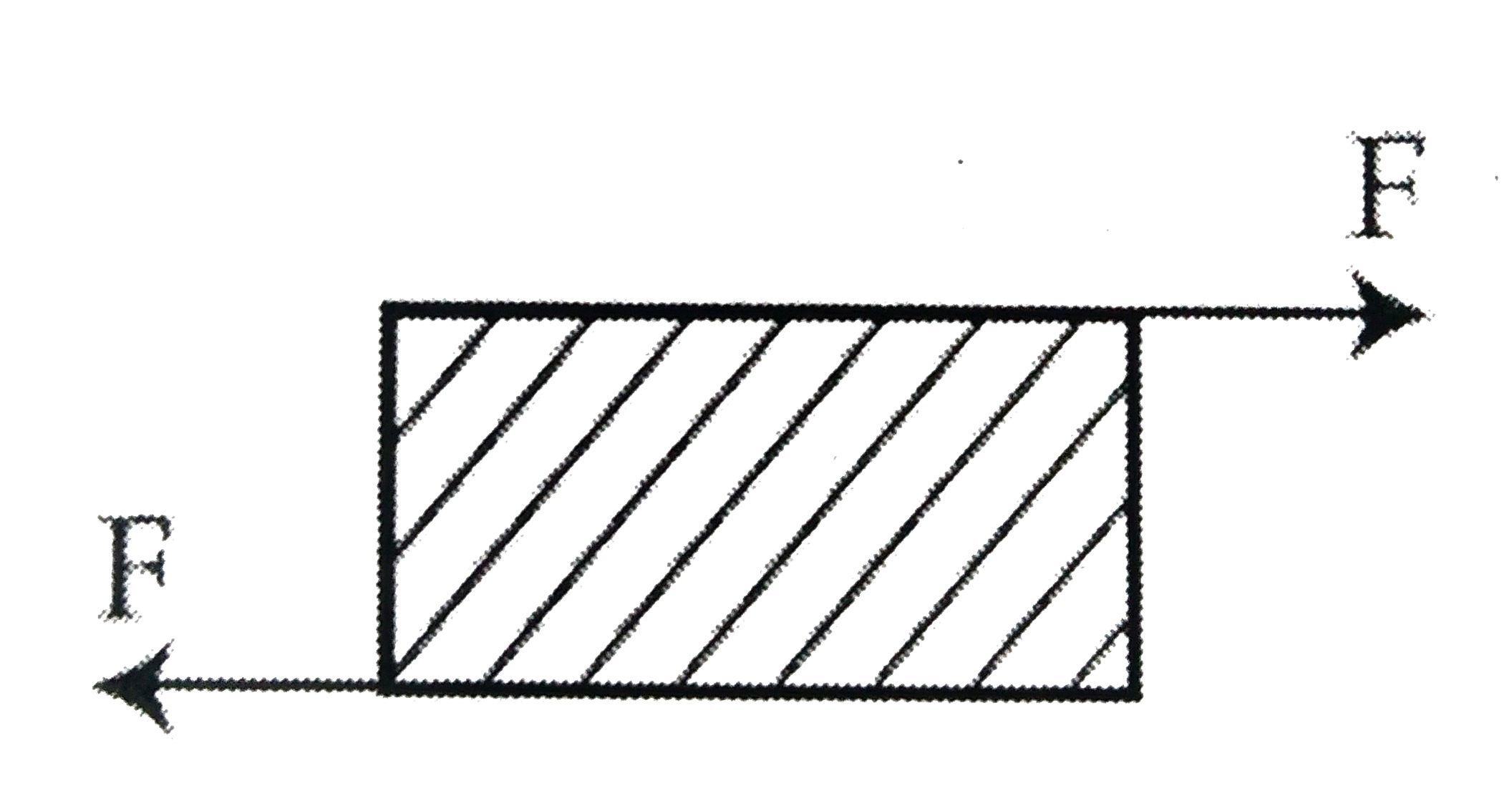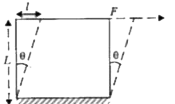Two parallel and opposite forces, each of magnitude 4000N, are applied tangentially to the upper and lower faces of a cubical metal block 25cm on a side. Find the angle of shear and the displacement of the upper surface relative to the lower surface. The shear modulus for the metal is 80GPa.
To solve the problem, we will follow these steps:
Step 1: Understand the Given Information
- Two parallel and opposite forces, each of magnitude F=4000N.
- The side length of the cubical metal block L=25cm=0.25m.
- Shear modulus G=80GPa=80×109N/m2.
Step 2: Calculate the Area of the Faces
The area A of one face of the cube is given by:
A=L2=(0.25m)2=0.0625m2
Step 3: Calculate Shear Stress
Shear stress τ is defined as the force per unit area:
τ=FA=4000N0.0625m2=64000N/m2
Step 4: Calculate the Angle of Shear
The angle of shear ϕ can be calculated using the formula:
ϕ=τG
Substituting the values:
ϕ=64000N/m280×109N/m2=8×10−7radians
Step 5: Calculate the Displacement of the Upper Surface
The displacement Δl of the upper surface relative to the lower surface can be calculated using:
ϕ=ΔlL
Thus, rearranging gives:
Δl=ϕ×L
Substituting the values:
Δl=(8×10−7radians)×(0.25m)=2×10−7m=2×10−5cm
Final Answers
- Angle of Shear: ϕ=8×10−7radians
- Displacement: Δl=2×10−5cm
- Two parallel and opposite forces, each of magnitude F=4000N.
- The side length of the cubical metal block L=25cm=0.25m.
- Shear modulus G=80GPa=80×109N/m2.
The area A of one face of the cube is given by:
A=L2=(0.25m)2=0.0625m2
Shear stress τ is defined as the force per unit area:
τ=FA=4000N0.0625m2=64000N/m2
The angle of shear ϕ can be calculated using the formula:
ϕ=τG
Substituting the values:
ϕ=64000N/m280×109N/m2=8×10−7radians
The displacement Δl of the upper surface relative to the lower surface can be calculated using:
ϕ=ΔlL
Thus, rearranging gives:
Δl=ϕ×L
Substituting the values:
Δl=(8×10−7radians)×(0.25m)=2×10−7m=2×10−5cm
- Angle of Shear: ϕ=8×10−7radians
- Displacement: Δl=2×10−5cm
Topper's Solved these Questions
- BOOK - CENGAGE PHYSICS ENGLISHCHAPTER - PROPERTIES OF SOLIDS AND FLUIDSEXERCISE - Solved Examples11videos
PROPERTIES OF SOLIDS AND FLUIDS
- BOOK - CENGAGE PHYSICS ENGLISHCHAPTER - PROPERTIES OF SOLIDS AND FLUIDSEXERCISE - Exercise 5.112videos
PROPERTIES OF SOLIDS AND FLUIDS
- BOOK - CENGAGE PHYSICS ENGLISHCHAPTER - NEWTON'S LAWS OF MOTION 2EXERCISE - Integer type1videos
NEWTON'S LAWS OF MOTION 2
- BOOK - CENGAGE PHYSICS ENGLISHCHAPTER - RIGID BODY DYNAMICS 1EXERCISE - Integer11videos
RIGID BODY DYNAMICS 1
Similar Questions
A steel plate of face area 4cm2 and thickness 0.5cm is fixed rigidly at the lower surface. A tangential force of 10N is applied on the upper surface. Find the lateral displacement of the upper surface with respect to the lower surface. Rigidity modulus of steel =8.4×1010Nm−2.
View SolutionA force Fis tangentially applied on the upper face of a cube of side b and whose lower face is fixed. If modulus of rigidity is n then upper surface of cube is shifted to
View Solution
Knowledge Check
- Question 1 - Select One
Two parallel and opposite forces each 5000 N are applied tangentially to the upper and lower faces of a cubical metal block of side 25 cm. the angle of shear is (The shear modulus of the metal is 80 Gpa)
A10−4radB10−5radC10−6radD10−7rad
The shear modulus for a metal is 50000Mpa. Suppose that a shear force of 200N is applied on the upper surface of a cube of this metal that is 3.0cm on each edge. How far will the top surface be displaced?
View SolutionA cube of side 40 cm has its upper face displaced by 0.1 mm by a tangential force of 8 Kn. The shearing modulus of cube is :-
View SolutionA 4 cm cube has its upper face displaced by 0.1 mm by a tangential force of 8 kN. Calculate the shear modulus of the cube.
View SolutionAs shown in the figure forces of 105 N each are applied in opposite direction on the upper and lower faces of a cube of side 10 cm shifting the upper face parallel to itselft by 0.5 cm if the side of another cube of the same material is 20cm, then under similar conditions as above the displacement will be
 View Solution
View SolutionA lead cube of side 20 cm is subjected under a shearing force of magnitude 5.6x106N. If the lower face of the cube is fixed, then the displacement in the upper face is (If shear modulus of lead is 5.6⋅106Nm2)
View SolutionA metal cube of side 20cm is subjected to a shearing force of 4000N. The top face is displaced through 0.50 cm with respect to the bottom. Find the rigidity modulus of the metal.
 View Solution
View SolutionThe lower surface of a cube is fixed. On its upper surface, force is applied at an angle of 30∘ from its surface. The change will be the type
View Solution

